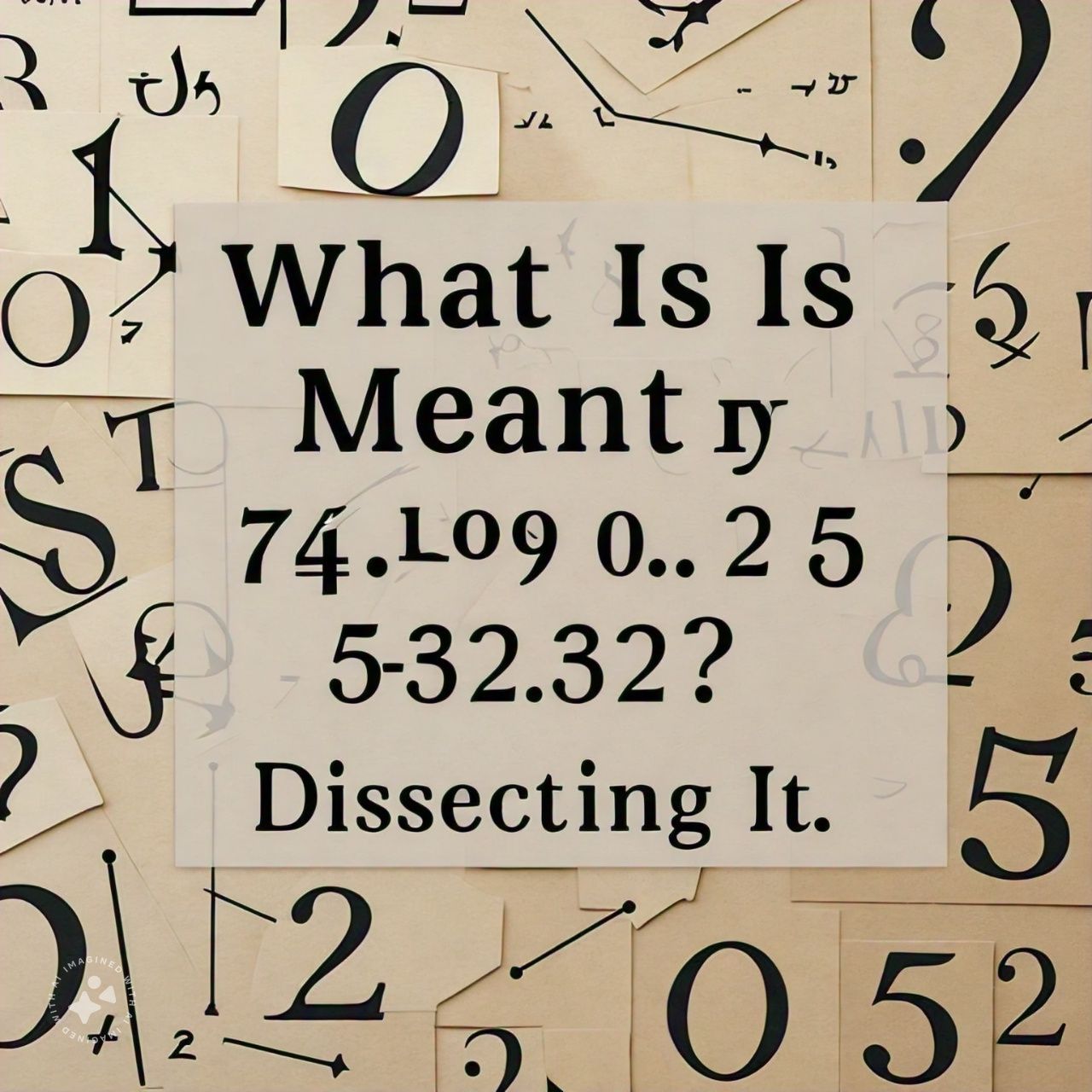Although numbers by themselves can have a powerful impact, they appear opaque when put in a particular pattern, like “74.09 0.23 5-32.32.” Have you ever come across this sequence and wondered, “What does this represent?” You’re not by yourself. Depending on the context in which they are used, these figures could represent anything. It could be statistical data, scientific findings, normal stock market swings, or even unofficially significant personal information.
But first, let’s discover the meaning of the numbers 74.09, 0.23, 5-32.32, and the locations of these digits. We’ll help you understand this numerical code, whether you’re a researcher, financial enthusiast, or just curious about it. We’ll explain what each figure means.
Dissecting 74.09 0.23 5-32.32: A Comprehensive Description
1. What is the meaning of 74.09? An Up-Close Look
First, let’s look at the number 74.09. Despite appearing to be any random number, its meaning usually becomes apparent as soon as the number is placed in context.
- Stock Price or Index: 74.09 is most frequently observed in the financial industry. The value of an index or a stock at a specific time could be the source of this information. A stock that is traded for 74.09 US dollars a share, for example, would make sense.
- Scientific Measurement: In the context of scientific measurement, 74.09 could represent a score that was acquired, for instance, by an experiment involving temperature, weight, or concentration.
- Percentage in Data: Similarly, 74.09 may indicate a percentage of a change, disposition, ratio, or outcome of an assessment.
2. Comprehending What 0.23 Means
It is possible to assign the subsequent element in the sequence 0,23 to being a member of the decimal or percentage value group. This is where this number frequently shows up:
- Financial Percentages: In the world of stock trading, 0.23 may indicate a little percentage—in this case, 0.23%—of a stock’s rise or fall in value.
- Scientific Data: This figure may be a fraction in a huge measurement, an error tolerance, or a success percentage, depending on your field of expertise.
Depending on the field of use, the very tiny coefficient of 0.23 may have significant implications. In the world of finance, even a minor alteration can have a significant effect, especially when big sums of money are involved.
3. 5-32.32 Interpretation: The Most Difficult Section
When compared to other sections of the Sequence, this 5-32.32 can be regarded as particularly difficult and unique. It might be a score, a range, or even a collection of measurements. This might be representative of or consistent with other weekly, monthly, annual, etc. evaluations. Let’s investigate a few potential interpretations:
- Sports Data: In sports, we may use 5-32.32 to represent performance over time, such as touchdowns scored, baseball games, and basketball goals scored.
- Measurement Ranges: 5-32.32 may be a range of values, particularly in technical domains like physics or engineering. For instance, a measuring scale may start with the number 5, and the greatest mean or peak value reached may be 32.32.
Because 5-32.32 can refer to a score, a range of performance, or time periods, its idiosyncrasies are semantically complex.
Where Would 74.09 0.23 5-32.32 Be Found? Typical Application Domains
1. Indicators of the Financial Market
Finance appears to be the only industry where these figures make the most sense. Certain numbers, such as 74.09 0.23 5-32.32, show up while concentrating on assets like stocks, bonds, or indices. They give analysts and traders the opportunity to track changes, gauge profitability, and forecast future shifts.
- A stock’s current price may be 74.09.
- The percentage change in the value of one currency relative to another might be 0.23.
It could represent earnings per share as well as targets like 5-32.32 profit margins.
2. Scientific Investigations and Tests
These figures could represent measurements in labs or scientific experiments. This is a reasonable mathematical statement that could be applied to research data to help interpret certain studies or experiments.
- For instance, a chemical compound’s concentration level might be 74.09.
- 0.23 could indicate both the efficacy of an experiment and the rate at which a response takes place.
Since it typically suggests some kind of time or error margin, the individual scores for classes 5 through 32.32 could also be quantitative ranges.
3. Sports Performance and Analytics
Without numbers, the sports world wouldn’t be complete. Both players’ and teams’ performance metrics are constantly being monitored, and figures like
- 74.09, 0.23, and 32.32 may be included in this assessment.
- 74.09 could be a player’s average score.
- Their win/loss percentage rise might be 0.23.
5-32.32 could track a player’s performance over the course of a season or with a large number of games left.
4. Technical and Engineering Domains
Measurements are extremely important in all engineering and building. Numbers like 74.09, 0.23, and 5.32 can be used to accurately differentiate the qualities of the material, as well as its dimensions and tolerances.
How to Gain Knowledge and Make Decisions using 74.09 0.23 5-32.32
1.Examining Financial Patterns
You need to do some analysis if you ever have numbers like 74.09, 0.23, and 5-32.32, particularly in the banking industry. These figures can indicate slight changes in equities or investment portfolios. Consequently, being able to comprehend these shifts will help with decision-making.
2. Increasing the Precision of Science
It is impossible to overlook a decimal point in the field of inquiry. As can be observed, certain values, such as 74.09, 0.23, 5-32.32, may be significant enough to determine if an experiment is successful or not. Confusion is avoided and accurate results and conclusions are reached thanks to the unambiguous figures provided here.
3. Improving Sportsmanship
The stats can only represent the sum of all that is done and accomplished in any game to an athlete, coach, or ardent fan. Teams use little numbers like 74.09, 0.23, and 5-32.32 to develop tactics, track their progress, and predict their efficacy.
Frequently Misunderstood 74.09 0.23 5-32.32
- Assuming Randomness: Despite the fact that this string of numbers is rather lengthy, it is frequently assumed that it was created at random. These figures might be useful in a particular field, application area, or usage assumption.
- Ignoring Minor Changes: Some people, for example, treat minor digraphs like 0.23 as though they are unaware of their subtler aspects. However, in many situations, these modest notations can take on a substantial importance, especially when technicalities or financial matters are at stake.
Why It’s Important to Understand Numerical Codes Like 74.09 0.23 5-32.32
Although those figures are nice, understanding numbers like 74.09 0.23 5-32.32 is crucial in the expanding data landscape of today. These numbers offer information that can alter a range of outcomes from investments to studies, regardless of your field—finance, science, or sports.
It implies that having the correct meaning can help you develop effective plans, make wise choices, and ultimately succeed in your field.
In conclusion
Prior to our analysis, 74.09 0.23 5-32.32 might appear to be a series of seemingly unconnected integers, but if they contain information, they can all be deciphered. You have probably tried examining scientific data, stock charts, or even game statistics, where analyzing such figures might provide valuable insights. In a data-driven world, it results in improved decision-making, optimal tactics, and a competitive edge when applied to each component.
FAQs
Can any field use 74.09 0.23 5-32.32?
Naturally, depending on the situation, this number sequence could be applied in the domains of engineering, science, sport, and finance.
What role does 0.23 play in the financial markets?
Depending on whether one is talking about thousands of shares, a percentage change in stock price, or other investment returns where even a slight difference seems to result into enormous profits or busts, the figure 0.23 is commonly followed by the letter k or the character “%.”
Is the range 5-32.32 always a range?
Not always. Depending on the particular field of applied discipline—sports, measurements, or scientific studies, for example—it could be a range, a score, or an interval.
In study, how can I appropriately evaluate these numbers?
Think about the connections between your data. A number of 74.09, a variation of 0.23, and experimental values of 5-32.32 might all be present.
What role does this pattern of numbers have in sports?
These figures can be used to evaluate a team’s success during a season in sports, and they might be scores, averages, or overall summaries of scores.



